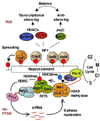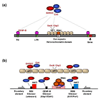RNAi-dependent formation of heterochromatin and its diverse functions
- PMID: 20207534
- PMCID: PMC3005588
- DOI: 10.1016/j.gde.2010.02.003
RNAi-dependent formation of heterochromatin and its diverse functions
Abstract
Expression profiling of eukaryotic genomes has revealed widespread transcription outside the confines of protein-coding genes, leading to production of antisense and non-coding RNAs (ncRNAs). Studies in Schizosaccharomyces pombe and multicellular organisms suggest that transcription and ncRNAs provide a framework for the assembly of heterochromatin, which has been linked to various chromosomal processes. In addition to gene regulation, heterochromatin is crucial for centromere function, cell fate determination as well as transcriptional and posttranscriptional silencing of repetitive DNA elements. Recently, heterochromatin factors have been shown to suppress antisense RNAs at euchromatic loci. These findings define conserved pathways that probably have major impact on the epigenetic regulation of eukaryotic genomes.
Published by Elsevier Ltd.
Figures


Similar articles
-
PhpCNF-Y transcription factor infiltrates heterochromatin to generate cryptic intron-containing transcripts crucial for small RNA production.Nat Commun. 2025 Jan 2;16(1):268. doi: 10.1038/s41467-024-55736-3. Nat Commun. 2025. PMID: 39747188 Free PMC article.
-
RNAi promotes heterochromatic silencing through replication-coupled release of RNA Pol II.Nature. 2011 Oct 16;479(7371):135-8. doi: 10.1038/nature10501. Nature. 2011. PMID: 22002604 Free PMC article.
-
Unique roles for histone H3K9me states in RNAi and heritable silencing of transcription.Nature. 2017 Jul 27;547(7664):463-467. doi: 10.1038/nature23267. Epub 2017 Jun 22. Nature. 2017. PMID: 28682306 Free PMC article.
-
Studies on the mechanism of RNAi-dependent heterochromatin assembly.Cold Spring Harb Symp Quant Biol. 2006;71:461-71. doi: 10.1101/sqb.2006.71.044. Cold Spring Harb Symp Quant Biol. 2006. PMID: 17381328 Review.
-
How does Hsp90 function in RNAi-dependent heterochromatin assembly?Curr Genet. 2019 Feb;65(1):87-91. doi: 10.1007/s00294-018-0866-0. Epub 2018 Jul 4. Curr Genet. 2019. PMID: 29974204 Review.
Cited by
-
Exosomal long non-coding RNAs in cancer: Interplay, modulation, and therapeutic avenues.Noncoding RNA Res. 2024 Apr 4;9(3):887-900. doi: 10.1016/j.ncrna.2024.03.014. eCollection 2024 Sep. Noncoding RNA Res. 2024. PMID: 38616862 Free PMC article. Review.
-
Panoramix SUMOylation on chromatin connects the piRNA pathway to the cellular heterochromatin machinery.Nat Struct Mol Biol. 2022 Feb;29(2):130-142. doi: 10.1038/s41594-022-00721-x. Epub 2022 Feb 16. Nat Struct Mol Biol. 2022. PMID: 35173350 Free PMC article.
-
Histone variants in metazoan development.Dev Cell. 2010 Nov 16;19(5):662-74. doi: 10.1016/j.devcel.2010.10.014. Dev Cell. 2010. PMID: 21074717 Free PMC article. Review.
-
SIRT6 deacetylates H3K18ac at pericentric chromatin to prevent mitotic errors and cellular senescence.Nat Struct Mol Biol. 2016 May;23(5):434-40. doi: 10.1038/nsmb.3202. Epub 2016 Apr 4. Nat Struct Mol Biol. 2016. PMID: 27043296 Free PMC article.
-
Putting CENP-A in its place.Cell Mol Life Sci. 2013 Feb;70(3):387-406. doi: 10.1007/s00018-012-1048-8. Epub 2012 Jun 23. Cell Mol Life Sci. 2013. PMID: 22729156 Free PMC article. Review.
References
-
- Gingeras TR. Origin of phenotypes: genes and transcripts. Genome Res. 2007;17:682–690. - PubMed
-
- Struhl K. Transcriptional noise and the fidelity of initiation by RNA polymerase II. Nat. Struct. Mol. Biol. 2007;14:103–105. - PubMed
-
-
Dutrow N, Nix DA, Holt D, Milash B, Dalley B, Westbroek E, Parnell TJ, Cairns BR. Dynamic transcriptome of Schizosaccharomyces pombe shown by RNA-DNA hybrid mapping. Nat. Genet. 2008;40:977–986. References and show that major portions of the S. pombe genome including intergenic regions are transcribed. These studies also identify extensive antisense transcription, and induction of large numbers of non-coding RNAs under different growth and environmental conditions.
-
-
- Wilhelm BT, Marguerat S, Watt S, Schubert F, Wood V, Goodhead I, Penkett CJ, Rogers J, Bahler J. Dynamic repertoire of a eukaryotic transcriptome surveyed at single-nucleotide resolution. Nature. 2008;453:1239–1243. - PubMed
Publication types
MeSH terms
Substances
Grants and funding
LinkOut - more resources
Full Text Sources
Other Literature Sources

